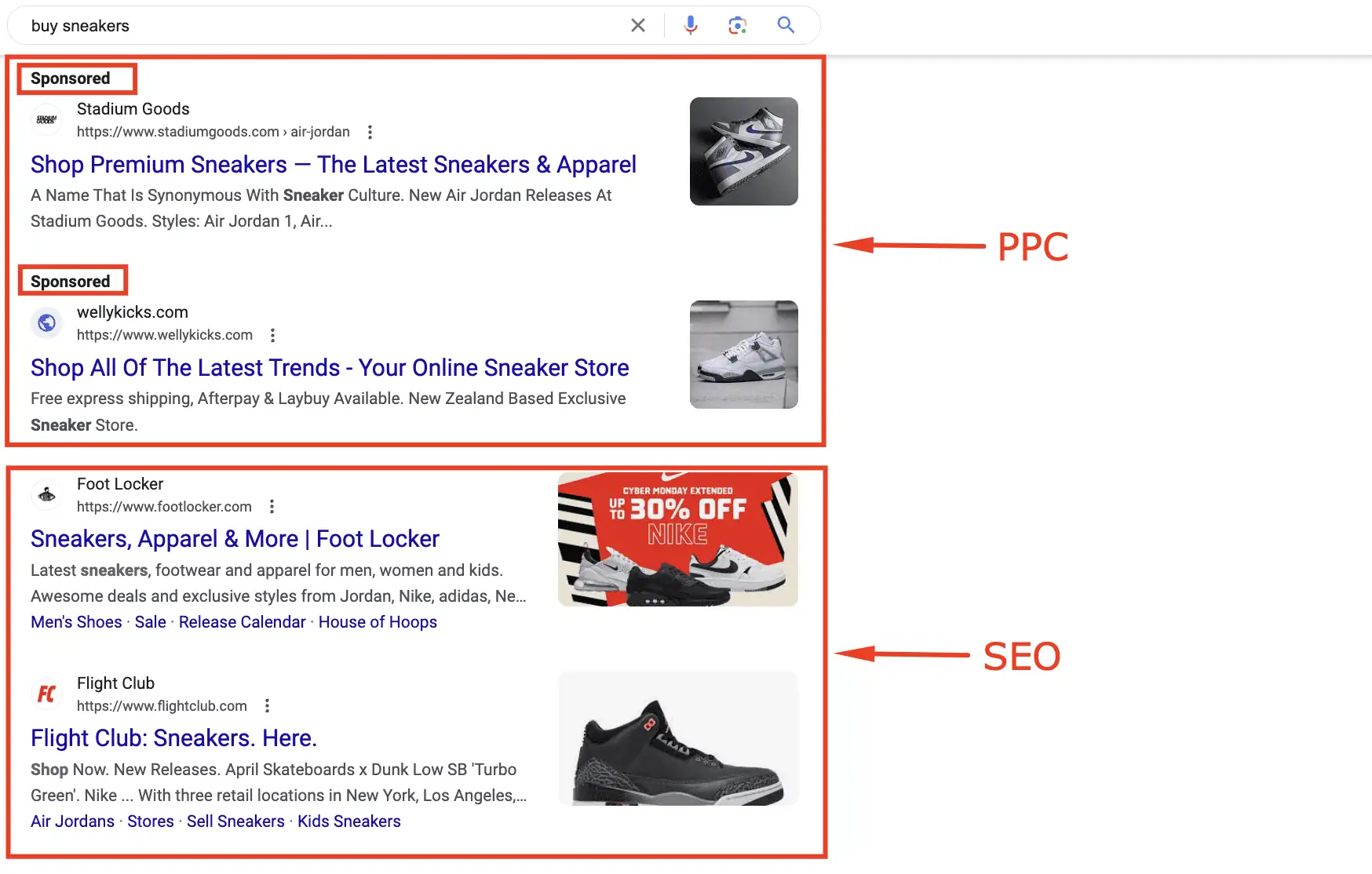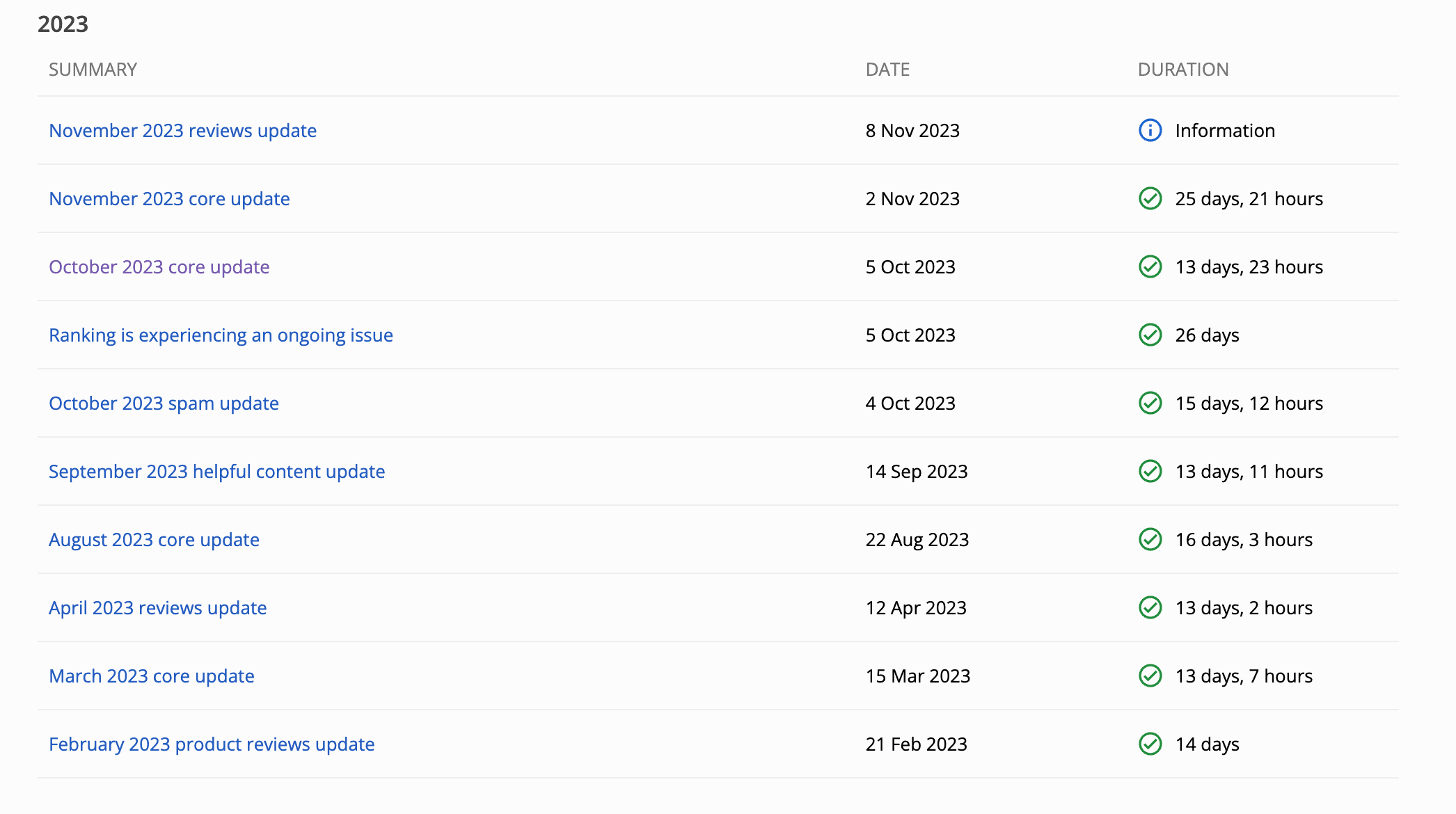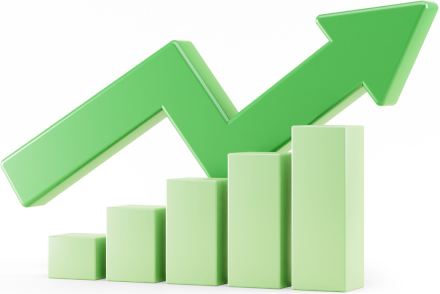Whenever users look something up in search engines, they see a list of pages that the algorithm finds relevant to their query. However, not all of them are in the same category: at the top of the search engine results pages, we see links with a “Sponsored” marker, followed by a list of organic search results.

The former show pay-per-click (PPC) advertising, while the latter are ranked by the search engine algorithms according to a range of factors that fall within the scope of search engine optimization (SEO). So, which of them should you choose for your site? And how is the ranking different when comparing PPC vs. SEO? Let’s analyze these two marketing strategies and compare the ranking aspects within them.
What Is PPC? (Pay-Per-Click)
Pay-per-click advertising is a part of search engine marketing (SEM) that involves an advertiser (a website owner) paying a publisher (for example, search engines like Google) for each click that they get on an ad shown to users. The goal of PPC ads is to attract visitors to a landing page and convert them into customers.
Key Components of PPC
PPC advertising involves several key components, including keyword research, the creation of an ad copy, ad bidding, budget control, performance tracking, and A/B testing. Google rates PPC ads with a Quality Score that evaluates your ad copy and keyword relevance. While this may seem straightforward, aspects like bidding, ranking, and ad formats require more careful consideration.
Bidding and Ad Rank
Bidding is when you decide how much you are willing to pay for a click. The price will depend on many factors, including the niche, the keyword difficulty, and the ad placement.
Your bid will influence how much your ad will be shown and how it will be ranked; if your competitors place higher bids, Google will give preference to their ads. Although the ranking is also impacted by your Quality Score and the expected impact of extensions and other ad formats, the bid amount is crucial, especially in highly competitive fields.
Ad Formats and Placement
Paid ads come in different formats. Search ads appear on search engine results pages (SERPs), while display ads are typically found on websites within the ad network (as part of Google Display Network (GDN)). Search ads are highly targeted; they are text-based and align with the user’s search query.
Display ads can include text, images, and videos designed to reach a wider audience. When it comes to placement, display ads require a strategic approach. It may depend on the PPC campaign objectives, target audience, and budget, but the main strategies here are targeting specific websites and retargeting techniques.
Advantages of PPC
The main advantages of PPC advertising include the following:
- Immediate Visibility: While strategies like SEO can take months to show results, PPC attracts traffic to your website almost instantly, giving you immediate results. Plus, it’s very easy to start a campaign on your chosen platform.
- Targeted Reach: Thanks to the use of keywords and the possibility of strategic placement, PPC ads reach a very targeted audience. Google, for example, allows you to target specific groups of people with your ads, whether by location, interests, age, or other factors.
- Testing and Experimentation: Considering that you can quickly see results from your PPC campaigns and adjust them as needed, this strategy allows you to test and experiment with your ad copies. A popular approach here is A/B testing, during which two ads are run at once and their performance is compared to decide which is more effective.
Challenges and Considerations in PPC
Despite the benefits, there are also significant challenges. The most important considerations are:
- Budget Management: The amount you pay for a click can vary greatly depending on your niche and the targeted region. Plus, to start a campaign, you need to have an initial investment. In the crypto niche, the average cost per click in the US is 89 cents, which means that the monthly spend can reach thousands of dollars.
- Ad Fatigue: Your campaigns will lose effectiveness if they run for a long time. This is due to ad fatigue: when people see your advertisements too often, they lose interest and become blind to them. Your ads will need to be constantly updated and refreshed to remain effective.
- Restrictions: Certain topics are not allowed to be advertised. This depends on the specific platform; for example, Google distinguishes unacceptable, restricted, and acceptable content. It restricts niches like gambling, healthcare, and finance. Crucially for crypto websites, financial products can be advertised by advertisers approved by Google in specific locations.
Lastly, as with many other practices, success is not guaranteed in PPC ads. Depending on the niche, the audience, or even the location, it may be more difficult to create a successful campaign and outperform competitors.
Recommended reading: Five Ways to Use Quality Score to Improve Your Performance – Google Ads Help
What Is SEO (Search Engine Optimization)

Search engine optimization is the practice of increasing the quantity and quality of traffic to a website through organic search engine results. It involves optimizing web content and structure to rank higher in SERPs, thereby enhancing visibility and accessibility to users. We wrote about the importance of SEO in detail in this article.
SEO Ranking Factors
SEO is a complex strategy that is aimed at improving your website according to several key ranking factors. The main areas of optimization are:
- Technical SEO: Search engines strive to provide users with the best user experience, so if they believe that a website loads slowly, is not optimized for mobile, or doesn’t have a secure connection, they will not rank it highly. Thus, technical SEO focuses on the optimization of site speed, mobile friendliness, and security.
- On-Site SEO: Another part of the user experience is the quality and relevance of the content offered by the website. Search engines value content quality and keyword optimization highly. They are part of on-site SEO, also known as on-page optimization.
- Off-Site SEO: Google also evaluates external signs of your website’s quality and authority. They include links to your website from other resources (backlinks), domain authority, and social signals. The optimization of these factors falls within the scope of off-site (or off-page) SEO.
Benefits of SEO for Long-Term Growth
The main advantages of SEO are the following:
- Sustainable Results: Unlike paid advertising, SEO is aimed at long-term results. A well-optimized website will continue to attract organic traffic through search results and backlinks even if you pause your SEO campaign.
- Cost Effectiveness: In SEO, you don’t need to constantly pay for clicks. Although it does require an initial investment, it is cheaper in the long run. A well-performed optimization will keep attracting traffic to the site, requiring minimal efforts aimed at ensuring that your content remains relevant and does not get outperformed.
In this case study, you can see how SEO can lead to steady growth even with a limited budget.
SEO Challenges and How to Overcome Them
SEO poses a few significant challenges that must be addressed in any SEO strategy.
- Competition: If your business belongs to a highly competitive niche, you will need to be on the constant lookout for your competitors’ attempts to outperform you. Competitor analysis should be a part of your overall marketing strategy, but it’s even more crucial for determining the right SEO strategies and getting better organic rankings for specific keywords.
- Algorithm Changes: Search engines work hard to improve their algorithms, presenting regular updates for the organic ranking system. Thus, ongoing optimization is necessary for websites that want to keep their positions. Recently, Google updates have become more frequent, so you have to stay up to date and anticipate future changes to not lose organic traffic.

These algorithm updates were implemented in 2023, as reported by Google.
SEO vs. PPC in Ranking
Immediate Impact vs. Long-Term Results
When you launch a PPC ad, you can notice almost immediate results. PPC advertising is well-suited for short-term campaigns, but it’s not great for yielding sustained results. On the other hand, SEO takes time, which is the main difference between the two approaches.
The time you’ll need to see the first results from your SEO strategy can vary greatly, but it usually takes a few months to complete initial technical optimization and start ranking for the chosen keywords and building backlinks. Through the creation of quality content, the use of the right keywords, and other tactics, SEO sets your website up for long-term success. However, after the initial optimization, you will still need to maintain the website to continue to drive traffic.
Cost Implications and ROI
When setting a budget for your digital marketing, PPC and SEO require different approaches. With PPC, you need to make a serious initial investment to start attracting potential customers. You should be able to start paying for ads right away, and the monthly budget will depend on the number of clicks you get and your bidding strategy. You will likely need to spend more than you will gain in the short term.
Search engine optimization is more cost-efficient and can offer a better return on investment in the long run. It offers flexibility in budgeting: you can perform some processes by yourself and outsource other tasks, although in highly competitive fields like the crypto niche, working with a professional agency is more effective.
Control and Flexibility in Strategy
Initially, SEO offers less control over your reach and the ability to make adjustments. The performance of your competitors and changes in search algorithms, which are beyond your control, can have an impact on this long-term strategy. However, SEO becomes more flexible after some time, as you can create different types of website content and adjust the factors that are more relevant to your goals.
PPC allows you to make immediate changes and set more precise targeting. While SEO has a more general reach, paid advertising can be targeted to defined groups of people. You can also quickly see if your campaign is working, which allows you more control over the results and more possibilities for testing and adjustments.
Audience Targeting and Engagement
Search ads can reach the right audience quickly; however, they are not aimed at keeping website visitors engaged. In most cases, PPC ads are better suited for attracting visitors to specific landing pages and converting them to customers.
SEO efforts, conversely, are aimed at creating a wider organic reach. With diverse content and improved user experience, you can engage visitors and make them more interested in exploring your website. SEO allows you to promote both commercial and informative content, contributing more to building a stronger online presence and brand awareness.

Synergies Between PPC and SEO
Leveraging Data Across Both Channels
Despite the differences between these two approaches, they overlap in the data used across them. Setting up online advertising campaigns requires you to research relevant keywords, which is also a significant part of SEO. The keywords targeted by your ads and those included in your SEO strategy will likely be similar or the same.
Google Keyword Planner, a research tool for Google Ads, can also help you determine keywords for your SEO campaign by providing data about terms used by your competitors and their search volume. However, if your PPC and SEO teams are not synchronized, they may start competing with each other for some queries. So if you decide to go with both strategies, it’s important to control this aspect.
Integrated Marketing Strategies
To get the best of the two worlds, you can combine the two strategies. Such a comprehensive approach will yield significant results for websites that have an appropriate budget.
Integrating the two channels requires consideration of the working processes, including the synchronization of keyword planning and the choice of pages for promotion. However, to have successful paid online advertising, you should first ensure that when visitors click on your ad, they are brought to a well-optimized page. So, starting with SEO is recommended.
Building Brand Awareness and Credibility
Although SEO is a great choice for strengthening your brand presence, it is mostly limited to how your website is shown on the search engine result page. For a wider reach, use PPC ads to represent your products or services on targeted websites through display ads.
At the same time, invest time and effort into creating quality content and building partnerships to establish your credibility. Growing your backlink profile through link building can contribute to not only such metrics as domain authority but also to brand recognition and authoritativeness.
Future Trends in PPC and SEO for the Crypto Industry
The future changes in search algorithms can influence not only the organic rankings but also the ads. Search engines have started to adapt to voice searches and improve their algorithms for checking the relevance and quality of content. In addition, they react to the evolving regulations regarding cryptocurrencies, easing the restrictions on paid ads for crypto in some regions.
The crypto marketing niche is also heavily impacted by the evolution of AI and machine learning. In PPC and SEO, this means opportunities for more precise targeting and data analysis. However, for the highly competitive crypto market, this creates the challenge of massive amounts of low-quality AI-generated content. Crypto websites need frequent content updates to stay relevant, so a comprehensive content strategy will remain a must.
Lastly, the volatility of the crypto markets can cause ups and downs in user activity. Both ad copies and website content need to be adapted to market trends. It’s critical to follow the news in the field and react swiftly.
Conclusion
SEO and PPC advertising are two important digital marketing strategies. A PPC campaign can help you get quick results if you can allocate a significant upfront investment, while SEO helps you build and sustain a strong online presence for the long term.
The choice between the two depends on your overall business strategy. However, crypto website owners should keep in mind that advertising opportunities are limited for financial products and services. Crypto businesses can still use some paid promotion platforms, but the largest providers like Google Ads have restrictions in place that make it difficult for them to advertise.
On the other hand, there are no limitations in SEO for crypto websites. In this tech-savvy field, websites benefit greatly from quality technical SEO, while on-site and off-site optimization can help your resource stand out from the competition. Thus, SEO is generally a more comprehensive and reliable solution for crypto websites.






